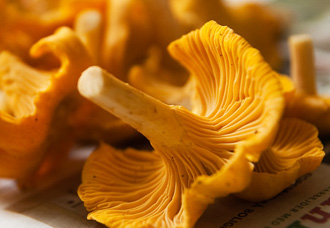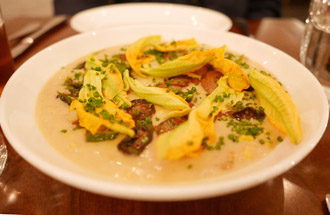Chanterelle Mushroom Nutrition
Chanterelle mushroom is funnel or trumpet-shaped wild mushroom known for its unique flavor, and culinary appeal. And for the same reason, chanterelle are popular among foragers and chefs in high-end restaurants, especially in North America and Europe.
Scientific name: Cantharellus cibarius; in the family Cantharellaceae within the fungal kingdom. They are often found in hardwood forests, where they have symbiotic associations with the roots of certain tree species like oaks, beeches, and pines.
 |
| Chanterelle mushrooms. Courtesy: bjaglin. |
Identification
Chanterelle are orange to yellow color bodied, fleshy wild mushrooms and their funnel-shaped or trumpet-shaped caps have a smooth, wavy margin.
They do not have true gills like many other mushrooms. Instead, they have ridges or wrinkles on the underside of the cap that run down the stem.
The stem of a chanterelle is typically the same color as the cap and is solid, not hollow. It is also typically thicker at the base and tapers toward the cap.
Chanterelles often have a pleasant fruity or apricot-like aroma, which can be quite distinctive.
Health benefits of Chanterelle mushrooms
Chanterelle is low in calories; 100 gram of fresh mushroom holds just 32 calories. Nonetheless, this highly prized gourmet mushroom is naturally rich in bioactive compounds, antioxidants, vitamins and minerals that promote health.
The dietary fiber (3.8 g per 100 g-10% of RDI) in chanterelles can promote digestive health by supporting regular bowel movements and aiding in the prevention of constipation.
Some compounds in chanterelle mushrooms, like ergosterol peroxide, may have anti-inflammatory properties, potentially providing relief from inflammatory conditions.
Chanterelle composes β-glucan, a polysaccharide compound which has cholesterol reducing properties and can help enhance the immune system's response to infections and potentially reduce the risk of illnesses.
Chanterelles are a good source of essential nutrients such as vitamins (particularly B vitamins like riboflavin, niacin, and pantothenic acid), minerals (including potassium, copper, and selenium), and dietary fiber. These nutrients play important roles in maintaining overall health.
Chanterelle mushrooms are good source of vitamin-D (ergo-calciferol). 100 g chanterelle composes 212 IU (32% of RDI). Vitamin-D plays a vital role in calcium and phosphate metabolism and bone health.
Chanterelle is one of the richest source of niacin (vitamin-B3). 100 g of this fungi carries 4.08 mg (25% DA). Niacin plays vital role in fat, and carbohydrates metabolism, and DNA repair.
| Principle | Nutrient Value | Percent of RDA |
|---|---|---|
| Energy | 32 Kcal | 1.5% |
| Carbohydrates | 6.86 g | 5.3% |
| Protein | 1.49 g | 2.66% |
| Total Fat | 0.53 g | 2.65% |
| Dietary Fiber | 3.8 g | 10% |
| Vitamins | ||
| Folates | 2 μg | 0.5% |
| Niacin | 4.08 mg | 25.5% |
| Pantothenic acid | 1.08 mg | 21% |
| Pyridoxine (B-6) | 0.044 mg | 3.3% |
| Riboflavin | 0.215 mg | 16.5% |
| Thiamin | 0.015 mg | 1% |
| Vitamin-D | 212 IU | 35% |
| Electrolytes | ||
| Sodium | 9 mg | 0.6% |
| Potassium | 506 mg | 10.7% |
| Minerals | ||
| Calcium | 15 mg | 1.5% |
| Copper | 0.353 mg | 39% |
| Iron | 3.47 mg | 43% |
| Magnesium | 13 mg | 3% |
| Manganese | 0.286 mg | 12.4% |
| Phosphorus | 57 mg | 8% |
| Selenium | 2.2 μg | 4% |
| Zinc | 0.71 mg | 6.5% |
How to choose
Chanterelles are typically in season during the late summer and fall, depending on the region and climate in the US and Canada.
If you foraging them in the wild, look for chanterelles that have a distinctive funnel-shaped cap with ridges running down the stem. The cap is typically orange or yellow but can vary in color. Avoid mushrooms with caps that are too bright or too pale, as they may be inedible or even toxic.
In the groceries or from the farmer's markets, buy in season: look for mushrooms that are firm, plump, and free from wrinkles or soft spots. Fresh chanterelles should have a clean and earthy or fruity aroma.
Avoid mushrooms that appear overly dry or discolored, any bruising, blemishes, or damage.
Storage
Chanterelles are best when used as soon as possible. They can be stored in the refrigerator for up to 3-5 days.
Place the cleaned and inspected chanterelles in a breathable container. A paper bag, a perforated plastic bag, or a cardboard box with holes punched in it work well. Avoid using an airtight container, as mushrooms need some airflow to stay fresh.
If you have a surplus of chanterelles and cannot use them all within a few days, consider drying them. Drying mushrooms is an excellent way to preserve their flavor and can extend their shelf life for several months. Once dried, store them in an airtight container in a cool, dark place.
Freezing is another option to extend their use. Place the blanched and dried chanterelles in airtight freezer bags or containers and store them in the freezer for up to 6-12 months.
Preparation and serving methods
Chanterelle mushrooms are known for their delicate, nutty flavor and are a culinary delight.
Always make sure to clean chanterelle mushrooms thoroughly before cooking and ensure they are properly cooked, as they should not be consumed raw.
 |
| Risotto- chanterelle and squash blossoms. Lou Stejskal |
Here are some serving tips:
Sautéed Chanterelles: Clean and slice the mushrooms, then sauté them in butter or olive oil with garlic, shallots, and a pinch of salt and pepper. You can also add fresh herbs like thyme herb or parsley for extra flavor.
Creamy Chanterelle Soup: Make a rich and creamy chanterelle mushroom soup. Sauté the mushrooms with onions and garlic, then simmer them in vegetable or chicken broth. Blend the mixture, add some cream or milk, and season to taste. Garnish with fresh herbs or a drizzle of truffle oil.
Chanterelle Risotto: Sauté the mushrooms along with Arborio rice, onions, and garlic. Slowly add chicken or vegetable broth while stirring until the rice is cooked and creamy. Finish with parmesan cheesee and a sprinkle of fresh herbs.
Chanterelle Pizza: Add sautéed chanterelles as a pizza topping along with mozzarella cheese and fresh herbs.
Employ sautéed chanterelle to prepare delicious omelet or pasta.
Chanterelle Stir-Fry: Incorporate chanterelle mushrooms into stir-fry dishes with a variety of vegetables and your choice of protein. The unique flavor of chanterelles will add depth to your stir-fry.
Safety profile
Chanterelle mushrooms are generally safe to eat and are a culinary delicacy enjoyed by many. However, accurate identification and proper cooking are essential to ensure their safety.
There are some toxic mushrooms that can look similar to chanterelles, such as the false chanterelle (Hygrophoropsis aurantiaca) and the jack-o'-lantern mushroom (Omphalotus illudens).
If you are new to foraging for mushrooms, it's advisable to learn from experienced foragers or seek guidance from experts to avoid any potential risks.
Some individuals may be allergic to mushrooms, including chanterelles and may want to avoid them.
Also read ≻≻-
≻≻- Shiitake mushroom nutrition facts.
≻≻- Oyster mushroom nutrition facts.
≻≻- Button mushroom nutrition facts.
≻≻-Back to Edible mushrooms from Chanterelle mushroom. Visit here for an impressive list of edible mushrooms with complete illustrations of their nutrition facts and health benefits.
≻≻-Back to Home page.
Further reading and Resources:
Ecology and Management of Commercially Harvested Chanterelle Mushrooms.
PubMed.gov- Soluble ß-glucan from Grifola frondosa induces tumor regression in synergy with TLR9 agonist via dendritic cell-mediated immunity.
Chanterelle (Cantharellus cibarius)-Woodland Trust.